
* The Bell Helicopter company had established itself with the piston-powered Model 47, which proved very popular and still remains in service. The next evolutionary step was to develop a helicopter using a turboshaft engine, which provided a higher power-to-weight ratio. The result was the "HU-1 Huey" for the US Army, which went into service as the "UH-1". The Huey was a huge success, with the initial "Model 204" series and enlarged "Model 205" series sold to the Army, Air Force, Navy, and Marines, as well as many foreign users. The Huey would become the enduring trademark of the US war in Vietnam.
* Although Bell had enjoyed little success with any of the company's piston helicopter designs besides the popular Model 47, the firm found another winner on 23 February 1955, when Bell was awarded the contract for a new US Army medical evacuation ("medevac") helicopter, with the company designation of "Model 204" and the initial military designation of "XH-40". Three prototypes were ordered, with initial flight of the first prototype on 22 October 1956.
The Model 204 was Bell's first production turbine helicopter. It was powered by a Lycoming T53-L-1 turboshaft providing 522 kW (700 SHP); used the traditional Bell main-tail rotor configuration, with two-bladed rotors and a stabilizing "teetering bar" on the main rotor; and was fitted with skid landing gear. The tail boom was fitted with a tailplane to help keep the helicopter level in forward flight.
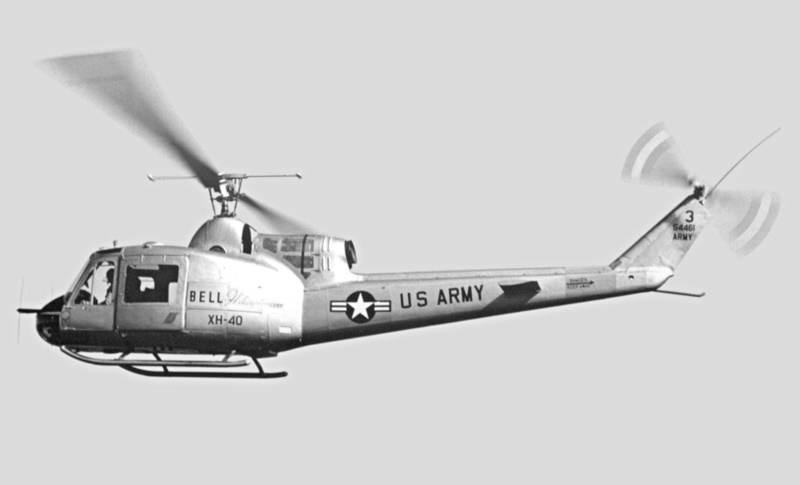
The three initial XH-40 prototypes were followed by six "YH-40" evaluation rotorcraft. The YH-40 featured a T53-L-1A engine providing 575 kW (770 SHP), and a cabin stretch of 30 centimeters (1 foot). The YH-40 could carry a pilot; copilot; and six passengers, or two stretchers mounted across the cabin plus a medical attendant. There was a sling attachment on the belly for hauling external cargo. Initial service delivery to the Army of the first of nine pre-production "HU-1 Iroquois" helicopters was on 30 June 1959. "HU" stood for "Helicopter, Utility", and the "HU-1" designation quickly led to the nickname that would be famous: "Huey".
The Army followed up with orders for a total of production 183 "HU-1As", including 14 configured with dual controls and "blind flying" kit for instrument training, which were given the designation of "TH-1A". Deliveries of the UH-1A were completed in 1961. The Army used the type for medevac in Alaska, Europe, and Korea. The HU-1 would be later deployed to Vietnam as the war there ramped up, and a number were field-fitted with a single Browning or M60 7.62-millimeter (0.30-caliber) machine gun on a fixed mount next to each side door, and twin forward-firing packs of 70-millimeter (2.75-inch) unguided rockets, with eight rockets per pack for a total of 16.
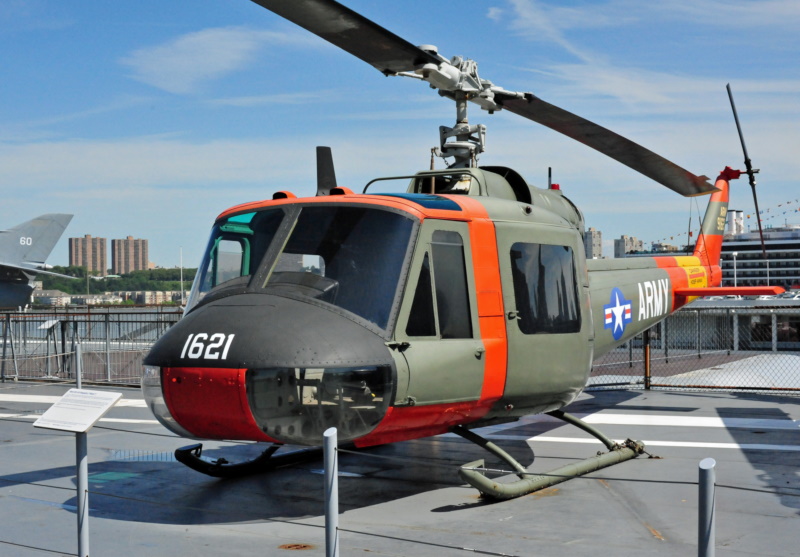
* The Army requested improvements to the Huey. The result was the "HU-1B", with first delivery in March 1961. The HU-1B had a stretched fuselage to provide accommodations for seven passengers; three stretchers, two sitting casualties, and a medical attendant; or 1,360 kilograms (3,000 pounds) of cargo.
The HU-1B was powered by a T53-L-5 turboshaft engine providing 716 kW (960 SHP), and was fitted with a redesigned rotor blade with wider span (13.4 meter / 44 foot) and wider chord, increased from 38 centimeters (15 inches) to 53 centimeters (21 inches). Late production UH-1Bs were fitted with a T53-L-9 or -L-11 turboshaft providing 821 kW (1,100 SHP), and some early production machines were field-upgraded to the more powerful engine as well. The major recognition featured of the UH-1B compared to the UH-1A was that the UH-1A had a taller rotor mast. Bell sold a commercial version of this variant designated "Model 204B" that was also purchased by some foreign military users. The Model 204B was rolled out in September 1960 and certified in April 1963. At least 1,033 UH-1Bs and Model 204s were built in all.
In September 1962, the US military adopted a new tri-service aircraft designation scheme, and the HU-1A became the "UH-1A", while the HU-1B became the "UH-1B". The UH-1B saw extensive service in Vietnam. It was initially fitted with the "M-6E3" armament system, which included two M60 machine guns mounted on an outrigger outboard of each door, for a total of four, and the existing eight-round rocket packs. The machine guns were aimed by the pilot using a cockpit-mounted sight and a hydraulic actuation system.
Transport versions of the UH-1 were known as "Slicks" because of their less cluttered appearance. They were generally armed with an M60 machine guns on a flexible mount in each door to provide covering fire for troops. The use of dedicated helicopter gunships to escort Slicks or "Dustoffs" (as medevac Hueys were known) led to a demonstrable drop in combat damage. In fact, although some Army brass believed that helicopters were too fragile to engage in frontline combat operations, Huey loss rates were found to be surprisingly acceptable, if hardly light.
* The UH-1B gunship lacked the power necessary to carry firepower and still keep up with transport Hueys, and so Bell designed yet another Huey variant, the "UH-1C", intended strictly for the gunship role. It featured the T53-L-11 engine of late-production UH-1Bs, with a modified intake system fitted with prominent air filters; and a new "Model 540" rotor system, with a blade chord increased further to 68 centimeters (27 inches). One of the main recognition features was that the pitot tube was moved from its standoff on the nose to the blade antenna on top of the cockpit. Some sources claim the Model 540 rotor system eliminated the teeter bar, but inspection of photographs show that not to be the case. A taller tailfin and a redundant hydraulic system were fitted as well.
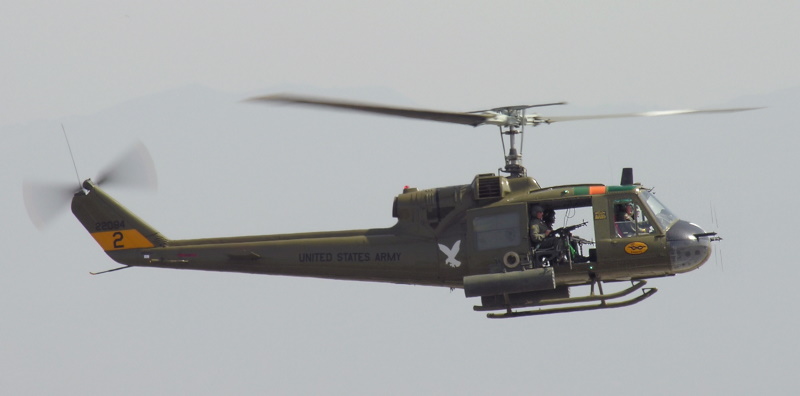
The UH-1C was introduced in September 1965, but only about 766 were built, since by that time Bell was getting ready to introduce the optimized AH-1 "Cobra" gunship, which was based on UH-1C technology. The "Cobra", as it was actually known in service, provided greater speed and maneuverability and, with its narrow cross-section, was a much more difficult target than the Huey gunships. The Huey gunship would still have its partisans, since its door gunners could lay down fire towards the rear of the helicopter and also provided extra sets of eyes. Huey gunships would actually remain in service in Vietnam up to the end of the war, if mainly due to the fact that there weren't enough Cobras to replace them.
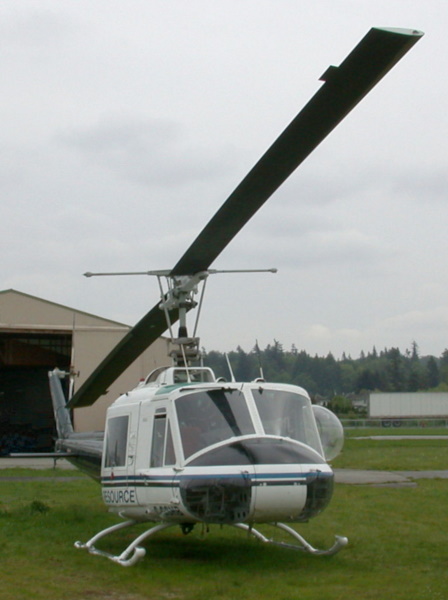
* Bell sold the Model 204 to civilian operators with some success. In 1968, Bell announced an uprated version of the UH-1C intended for "flying crane" duties and designated the "Huey Tug". The Huey Tug featured a Lycoming T55-L-7 turboshaft engine providing 1,977 kW (2,650 SHP); a stronger transmission system; a 15.24-meter (50-foot) rotor; a bigger tail rotor; a longer tail boom to provide clearance for the wider rotor; and structural improvements. Bell offered the Huey Tug as an upgrade to existing UH-1s, but there were no buyers for the upgrade package.
BACK_TO_TOP* UH-1B and UH-1C gunships were fitted with a series of improved armament systems:
A Huey gunship with an M-5 was called a "Frog"; one with the XM-3 was called a "Hog"; and one with both was called a "Heavy Hog". It seems that door guns were usually fitted as well, and there were of course many variations, such as fits that used the XM-159 19-round rocket pods in place of the XM-158 7-round pods.
There were also improvised weapon mounts. Some Hueys were fitted with wooden chutes outside the doors to allow flight crew to drop mortar rounds on enemy positions, with aircrew simply yanking the bottom doors of the chutes open with wires to drop the loads. This "Mortar Aerial Delivery (MAD)" scheme was reportedly very effective in jungle fighting. Another scheme said to have been used was to drop a 208-liter (55 US gallon) drum full of gasoline and hooked up with a grenade as an informal incendiary.
Soldiers tend to be ingenious in cooking up their own means of destruction. Incidentally, that was not the only case of such ingenuity: during fighting with Islamic militants in 2007, the Lebanese Army rigged up one or more Hueys to carry 225-kilogram (500-pound) aircraft-type bombs on each stores pylon. Apparently the "Hueybombers" proved very accurate and devastating in strikes.
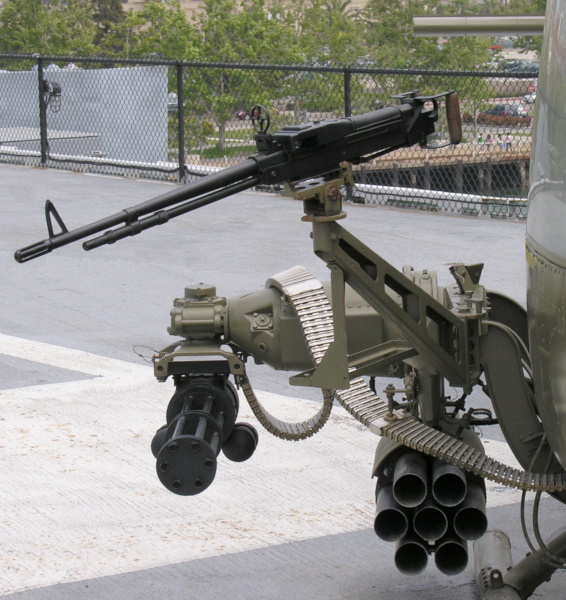
Some UH-1Bs were also fitted with six French "SS-11" wire-guided anti-tank missile, adopted by the US as the "AGM-22B", but it was never a popular weapon. The SS-11 had to be guided by "eyeball", with the operator tracking the missile by a flare in its tail and adjusting its course with a joystick. The course corrections were transmitted to the missile by wires that it spooled out in flight. Such a scheme required a highly trained operator and a more or less cooperative combat environment to be accurate, and as the first was in short supply and the second was almost a logical contradiction, accuracy of the SS-11 was very poor.
In the spring of 1972, in the last days of the US involvement in Vietnam, a number of UH-1Bs were fitted with the new BGM-71 "TOW (Tube-launched, Optically-tracked, Wire-guided)" missile. TOW, as its name implied, was a wire-guided missile like the SS-11, but had a much "smarter" guidance system. The weapons operator simply kept the sight on target, and the guidance system figured out the course updates. 81 TOW missiles were fired at that time, scoring 57 hits. In contrast, 20 SS-11 missiles were fired but only scored three hits. The use of TOW in Vietnam paved the way for its widespread adoption as a helicopter store in the post-Vietnam period.
* The last variant of the Model 204 bought by the Army was the "UH-1M", which was obtained both as new-built rotorcraft and as conversions from UH-1Cs. The UH-1M featured a T53-L-13 engine providing 1,044 kW (1,400 SHP). It was fitted with the "Iroquois Night Fighter And Night Tracker (INFANT)" sensor system with a low-light-level TV and a searchlight, plus an M-21 gun system, with both the sensor and weapons systems built by Hughes.
The UH-1M went into service in Vietnam in 1969. Some sources claim that only a few were built for evaluation, but other sources state that several platoons were equipped with the type. Model 204s also went into service with civil operators.
BACK_TO_TOP* In March 1962, Bell won a Marine Corps contract to supply the service with an assault support helicopter, resulting in the "UH-1E". The Marines obtained 250 UH-1Es, which were similar to the UH-1B but fitted with an external rescue hoist; a rotor brake to keep the rotor in place during shipboard stowage; and avionics fit to Marine specifications. First flight of the UH-1E was in February 1963. Deliveries began in February 1964. The Model 540 rotor system, used on the Army UH-1C, was introduced into UH-1E production in 1965. The Marines also obtained 20 "TH-1E" trainers.
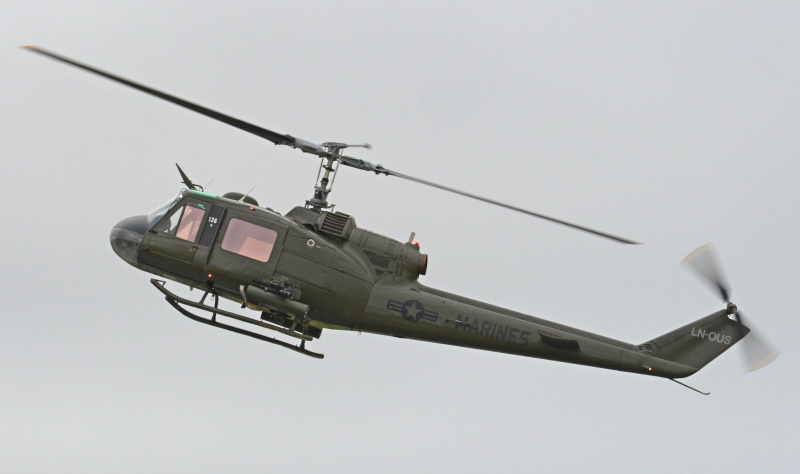
___________________________________________________________________
BELL MODEL 204 / UH-1E HUEY:
___________________________________________________________________
rotor width:
13.41 meters (44 feet)
footprint length:
16.15 meters (53 feet)
fuselage length:
12.08 meters (39 feet 8 inches)
height:
4.44 meters (14 feet 7 inches)
empty weight:
2,155 kilograms (4,750 pounds)
max loaded weight:
3,855 kilograms (8,500 pounds)
maximum speed:
220 KPH (140 MPH / 120 KT)
service ceiling:
5,090 meters (16,700 feet)
range:
340 kilometers (210 MI / 185 NMI)
___________________________________________________________________
* In June 1963, Bell won a US Air Force contract for a helicopter to perform missile site support duties, resulting in the "UH-1F", a derivative of the UH-1B. The UH-1F had the 14.63-meter (48-foot) diameter rotor and a General Electric (GE) T58-GE-3 turboshaft engine providing 963 kW (1,290 SHP). The GE engine was selected in favor of the Lycoming because the Air Force had an overstock of GE T58s and wanted to make use of them. The first UH-1F flew on 20 February 1964, with service deliveries beginning in September 1964. A total of 146 was built. The TH-1F was easily distinguished from other Model 204s by the fact that it had twin blade antennas in tandem on top of the cockpit, and the engine exhaust was on the right back side of the engine housing, not in the rear.
27 "TH-1Fs" were built for instrument flying and hoist training. 20 UH-1Fs were converted to USAF "UH-1P" configuration. Officially, these machines were supposed to be psychological warfare rotorcraft, carrying loudspeakers over the jungles of Vietnam to call on the enemy to surrender. In reality, they were covert operations gunships, with twin pintle-mounted Miniguns and two rocket pods. The cover story seems to have worked, since many sources still claim that the UH-1Ps were psychological warfare machines.
* Bell developed a variant of the UH-1B designated the "HH-1K" for the US Navy, with 27 built for "search and rescue (SAR)" duties. These rotorcraft were fitted with a Lycoming T53-L-13 engine providing 1,044 kW (1,400 SHP), and had Navy-specified avionics. Initial deliveries were in 1970. 90 more were built as training helicopters under the designation "TH-1L Seawolf", and eight were built as "UH-1L" utility rotorcraft.
The Navy also operated hand-me-down Army UH-1B gunships in Vietnam, in support of river patrol boats. The gunships would scout ahead of the patrol boats to look for ambushes and back up the boats during a firefight. In addition, various Huey models were operated by "Air America", a front company operated by the US Central Intelligence Agency that performed various clandestine and semi-clandestine air activities. Apparently, the Navy retired the last of its UH-1s in the late 1970s or early 1980s.
BACK_TO_TOP* Even as Bell was working on improved versions of the Model 204, the company was developing a new series of "stretched" Hueys, with the company designation of "Model 205". Bell proposed the concept to the Army in 1960, leading to award of a contract in July 1960 for seven "YUH-1D" prototypes.
The Model 205 first flew on 16 August 1961 and was introduced into service in August 1963 as the "UH-1D". It was based on the UH-1B and featured a Lycoming T53-L-11 turboshaft engine providing 821 kW (1,100 SHP), though some early production had the -L-9 engine; a 14.63-meter (48-foot) rotor with a 53-centimeter (21-inch) chord, the tailboom being stretched to clear the longer rotor; 34% more fuel capacity and provisions for auxiliary tanks; and a load capacity of 12 to 14 passengers, or six litters and a medical attendant, or up to 1,800 kilograms (4,000 pounds) of cargo.
The Model 205 could be easily distinguished from the Model 204 by the fact that the side doors had two windows, not one, and its skids were mounted at an angle that gave the UH-1D a nose-up attitude on the ground. Early UH-1Ds had the same intake scheme as the UH-1B, but later production had a new filtered inlet system. The Model 205 became the Army's primary combat transport and medevac helicopter in Vietnam. The Army generally assigned the smaller Model 204 variants to the gunship role.
The US Army bought a total of 2,008 UH-1Ds. Some were converted to "HH-1D" crash rescue machines, with a water spray system, rescue hoist, and medical facilities.
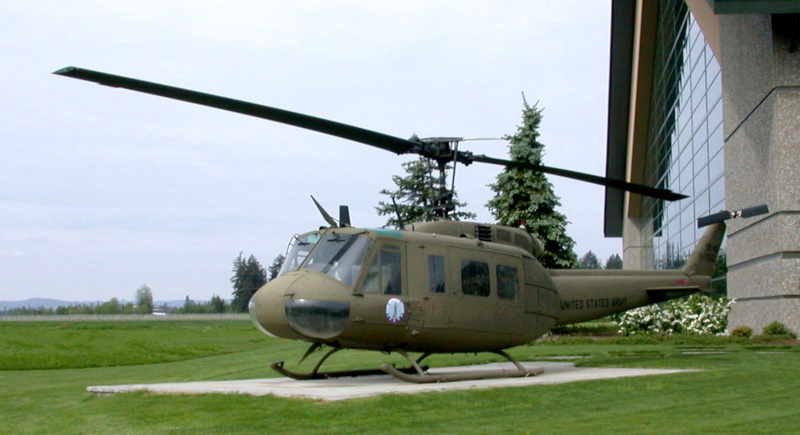
* The UH-1D led to the improved "UH-1H", which was generally similar but was fitted with the more powerful T53-L-13 engine providing 1,044 kW (1,400 SHP), as well as avionics for night and bad-weather operation, and a radio navigation system. The major recognition feature of the UH-1H was relocation of the pitot from the nose to the roof, just as with the UH-1C.
The UH-1H began to roll off the manufacturing line in September 1967 and remained in production for 20 years, with many UH-1Ds upgraded to UH-1H standard. The US Army obtained a total of 3,573 UH-1Hs, and many remain in service with Army Reserve / National Guard units. They were updated in service current with new avionics, improved composite rotor blades, countermeasures equipment such as chaff-flare dispensers, cable cutters, warning receivers, infrared jammers, and other updated gear.
Three UH-1Hs were modified to the "EH-1H" signals intelligence (SIGINT) standard. Many more such updates were planned, but the Army decided to adopt the Sikorsky "EH-60C" Black Hawk for this role instead. At least four UH-1Hs were converted to the "JUH-1H Stand-Off Target Acquisition System (SOTAS)", which featured extended landing skids and a rotating ground mapping and targeting radar pod under the fuselage; the landing skids could be semi-retracted to allow the radar pod to rotate. The scheme did not go into production, since the Army decided to use the Black Hawk for the role, then abandoned that scheme in turn to adopt the E-8 Joint STARS platform, based on the Boeing 707 airliner, for the battlefield observation role.
220 UH-1Hs were converted to the "UH-1V" medevac standard, with a radar altimeter for low-visibility flight operations and an improved rescue hoist, plus the cable cutters, warning systems, IR jammer, and facilities for chaff-flare dispensers. The USAF also obtained 30 similar "HH-1Hs" with a rescue hoist and belly navigation radar for short-range SAR.
___________________________________________________________________
BELL MODEL 205 / UH-1H HUEY:
___________________________________________________________________
rotor width:
14.63 meters (48 feet)
footprint length:
17.62 meters (57 feet 10 inches)
fuselage length:
12.8 meters (41 feet 11 inches)
height:
4.41 meters (14 feet 6 inches)
empty weight:
2,365 kilograms (5,210 pounds)
max loaded weight:
4,310 kilograms (9,500 pounds)
maximum speed:
205 KPH (125 MPH / 110 KT)
service ceiling:
3,840 meters (12,600 feet)
range:
510 kilometers (320 MI / 280 NMI)
___________________________________________________________________
In addition, 1,372 UH-1Hs were built for export sales, not counting foreign license manufacture.
* In Vietnam, the Model 205s were generally fitted with an M60 machine gun in each door as well as cabin armor, reducing passenger lift capacity to about 7 or 8 troops. The UH-1H with its more powerful engine was regarded as vastly superior to the UH-1D in terms of lift capacity, particularly under "hot and high" (hot temperature and high ground altitude) conditions, and became the standard Dustoff helicopter.
Dustoffs generally carried rescue hoists, which could be fitted with simple harnesses; harnesses that could penetrate jungle canopy; or various types of litters. Dustoff operations were usually unescorted and very hazardous, with loss rates about three times greater than those for other classes of helicopter operations. Dustoffs were unarmed except for the crew's personal sidearms and painted with red crosses -- but Vietnam was not a war of any niceties, and the red crosses only seem to have made them better targets.
4,869 helicopters were lost by US forces in Vietnam. The US Army's Hueys took the biggest part of these losses, a total of 2,591. Interestingly, only 1,211 Hueys were lost in combat, while 1,380 were lost in operational accidents. Statistics showed that helicopters were by no means inherently vulnerable, with a loss rate of less than one in 8,000 sorties. The high losses reflected their heavy use and not their fragility, with the heavy use leading to crew fatigue that contributed to the high accident rate.
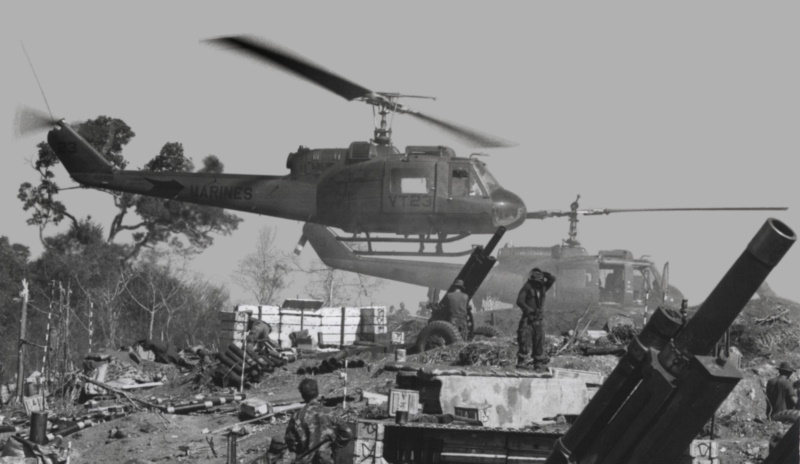
Huey production reflected the course of the war in Vietnam, going from 20 per month in 1963, to 160 per month in 1967, and then back to 10 per month in 1973. Vietnam has been judged the "first helicopter war", and certainly the Huey remains a symbol of the conflict far more than any other weapon, from images of Hueys dropping troops into landing zones, to pictures of Hueys thrown off aircraft carriers during the frantic final evacuation.
* Although the last UH-1s were retired from US Army service in 2016, a few may still be flying. From 2016, the Aurora Flight Sciences company worked on an unpiloted modification of the UH-1H for cargo delivery, under the Office of Naval Research's "Autonomous Aerial Cargo / Utility System (AACUS)" investigation.
The company had already flown a robot version of the Boeing Little Bird helicopter, the "H-6U"; the UH-1H modified with an updated version of the system was designated the "AACUS-Enabled UH-1H (AEH-1)", with test flights from 2017. The AACUS system used lidar (light radar) and camera sensors to avoid obstacles and evaluate landing zones; it was controlled by a tablet computer. The AACUS system could be readily ported to other rotorcraft.
BACK_TO_TOP